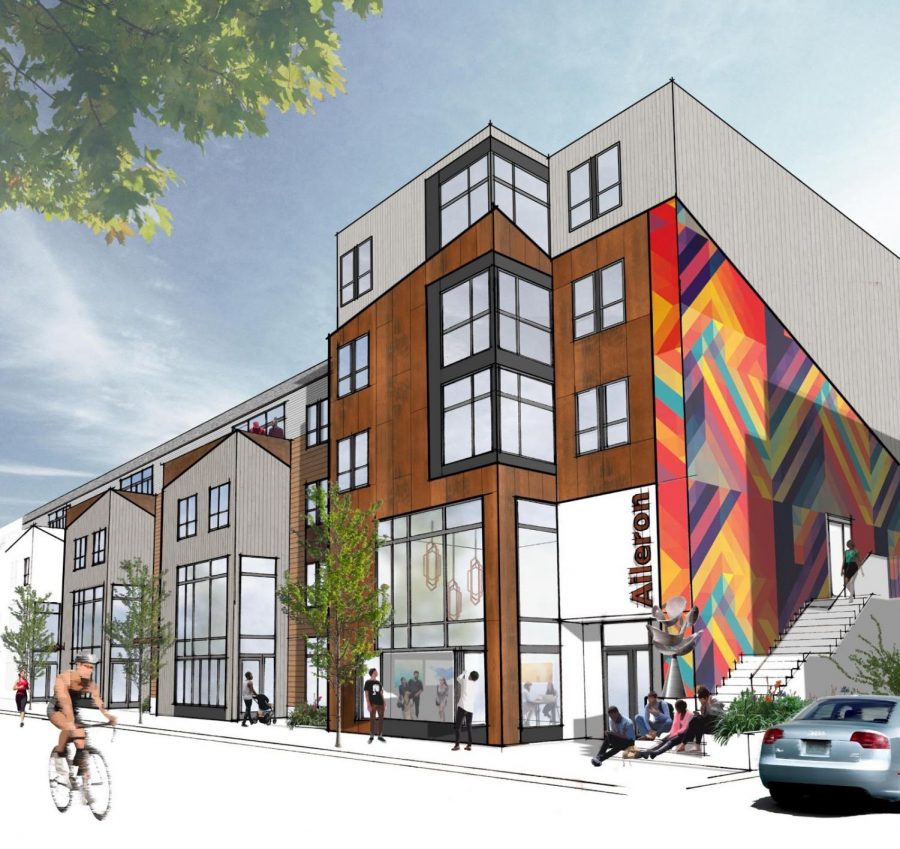Analyzing architecture
In the final installment of the career-focused series, tjTODAY explores careers in architecture
Image courtesy of Sharon Gentges
A rendering of a building designed by Gentges (class of 1992) features colorful sides and boxy modern construction.
June 2, 2021
Art and tech. While these fields seem like opposites, there are careers where they can blend nicely. In this series, we have already covered animation, but there are other careers where art and technology come together to create amazing things. One of these is architecture. To learn more about the career, tjTODAY interviewed 2 architects: Katie Atwater, class of 2003, and Sharon Gentges, class of 1992.
Architects of course design buildings, but their work extends much further than that. Architects are involved in a number of activities; they attend various meetings, sometimes design the streetscapes around buildings, and work with vendors and local government. The career encompasses many areas, from art to engineering to even litigative work and ethics.
“A lot of the stuff that I do is creating construction documents through a three-dimensional model, in a software called Revvit. There’s also a lot of meetings. There’s designing, picking finishes,” Atwater said. “ The fun part is the artistic part, conceptual design, [which is] modeling of what the building is going to look like in the end.”
Gentges added that other fields not typically associated with the career, like legal work and statistical analysis, are also significant.
“There’s definitely some spreadsheet work [in] trying to understand the program and how many of a certain thing a client needs and checking square footage and costs. So [that’s] some sort of math analysis that happens,” Gentges said. “There’s also definitely the understanding of the legal side of things. If a project starts to go bad, you need to protect the owner, you need to make sure the building is being built to code. You have to understand people’s contractual rights.”
Atwater mentioned that the work an architect does varies a lot depending on what type of firm and what type of architect they are, and there’s room for architects to deepen their knowledge in the parts of architecture they enjoy the most.
“It does vary a lot depending on what kind of architecture you’re working on and also the size of the firm that you’re working in– the firm I work in is like 20 people, which is relatively small. I design buildings, but I also do construction administration, so when the projects go into construction, I’m the one that goes out to the site once every two weeks to review what’s been built in, whether it’s in accordance with the drawings that we made, and running meetings,” Atwater said. “You may work at a firm that just [builds] single family houses and see if that seems like something that you would want to do, versus working at a huge firm where you might only work on facade details for years and years. Some people really love that, getting into the weeds of exactly how windows screw together and things like that, but I could care less about [facade details] so even though I still have to do a little bit of that, it’s not my full-time job.”
“The appeal of architecture, for Gentges, stems from problem solving, and she likened the process of fitting a design to certain constraints to an enjoyable puzzle.
“You have all these different factors and you have to find a way to accommodate them all. And so I do love the initial phase, which is what we call schematic design, because I like seeing how all these pieces might fit together, helping my clients understand what the trade-offs are between different design options, and then coming up with a solution that is the best balance for all of these different constraints,” Gentges said.
Atwater also mentioned that architecture is not only puzzle-solving, but doing so in an artistic way. While something like physics can also be considered puzzle-solving, that generally has a single solution. Atwater was interested in engineering, but wanted something more creative.
“My dad has an engineering background. He’s a PhD in physics, which sounds like the worst possible thing you could do to me, and my mom is very artistic– she does a lot of fiber arts and things like that– so I kind of grew up around all of that stuff,” Atwater said. “Architecture was a nice combination of the engineering brain and the problem solving, but also with an artistic bent to it.”
On a similar note, Gentges also had a background in physics before going into architecture.
“When I graduated from TJ, I thought I wanted to be a physicist. And so my undergraduate degree was in physics. But, I worked in a lab one summer and I really didn’t like it. So I was looking for something that combined the arts and the sciences and something that could actually have a real impact on people’s lives,” Gentges said.
Gentges also pointed out another difference between architecture and other careers in engineering: specialization.
“I like to think that engineers are specialists and they know a whole lot about their one subject, but as an architect, I’m a generalist, which means I know a little bit about all of the subjects, and so I have to know when to ask the right questions of my engineers,” Gentges said.
For both Atwater and Gentges, getting to see something they created on a computer being built and used is one of the highlights of the career. Atwater mentioned the gratification of seeing fire stations she had designed.
“I’ve designed primarily fire stations at this point, which is kind of cool. It’s a very niche area, but you design a building that serves the community for 50 or 75 years. It’s really fun to me to be able to drive down the street and be like, ‘Oh, I designed that!’ Or I remember when that was first being conceived and what it was supposed to look like and what it looks like now,” Atwater said. “And I think that’s been really exciting for me to see over the course of my career.”
But how did their experiences at Jefferson influence their decision to become architects? Atwater mentioned her senior tech lab.
“Both the CAD lab [what we now call Freshman CAD] and then the senior tech lab, I think both of those helped me understand that it’s about being self-motivated to a certain extent and that’s helped me immensely throughout my career– [knowing that] if I don’t put the time and effort into it, I’m not going to enjoy it,” Atwater said. “It’s really finding something that you want to spend that time and effort on that is the key to finding a good career.”
At the same time, Gentges had a different experience, disliking certain STEM aspects of architecture in high school, though she later found that other humanities-oriented experiences helped when she became an architect.
“We did CAD drafting [in] freshman tech and I hated it,” Gentges said. “But I think humanities classes and just understanding the relationship between the way societies build themselves up and the art and the architecture and how that relates to what’s going on in history– they help you understand the way that these things exist [and] the way that what we do has meaning. So later [in college], someone mentioned the Myers-Briggs test, I did it again and architecture showed up as one of the careers and it was like a light bulb went off. ”
For Jefferson students wanting to pursue architecture, both Atwater and Gentges suggest internships and other experiences to get a better notion of the career. They also mentioned that, as architecture is often done as a graduate course, there is no pressure to make this decision now.
“Don’t feel like you’re pigeonholed into this stuff. The way that architecture schools are set up now, you can either do an undergrad degree and then two to three years of grad school, or you can do a five-year undergraduate, and get a bachelor’s at the end, that’s a professional or pre-professional degree,” Atwater said. “ But don’t feel like you have to start it right away if you don’t know what you want to do, start with whatever you feel comfortable in, and you can always switch into it or graduate with a bachelor’s and then go to go to grad school. You pick up right where everybody else is, since that [switch] happens all the time. I think this decision is really about figuring out whether you enjoy it or not.”
Lastly, on the topic of figuring out whether you enjoy architecture, both Gentges and Atwater highlighted pursuing internships and work experience as incredibly important.
“If you have opportunity to work in an architecture office at some point, that would be great, just because the practice of it is so different from what people imagine,” Gentges said.






